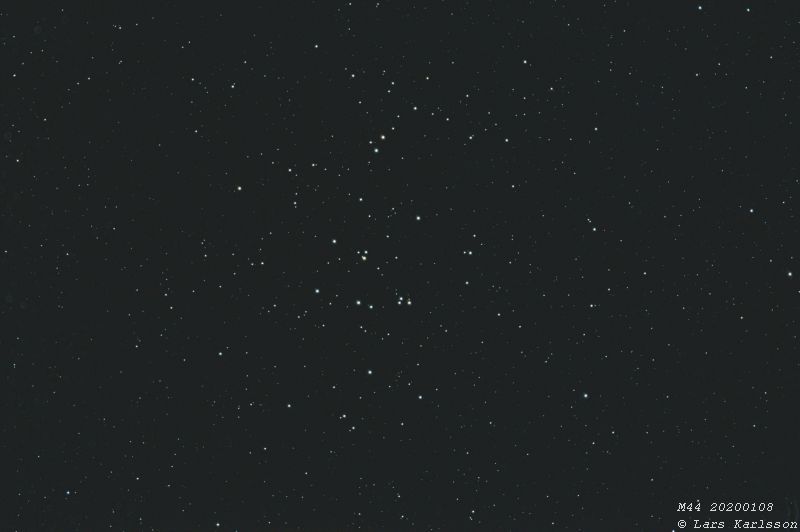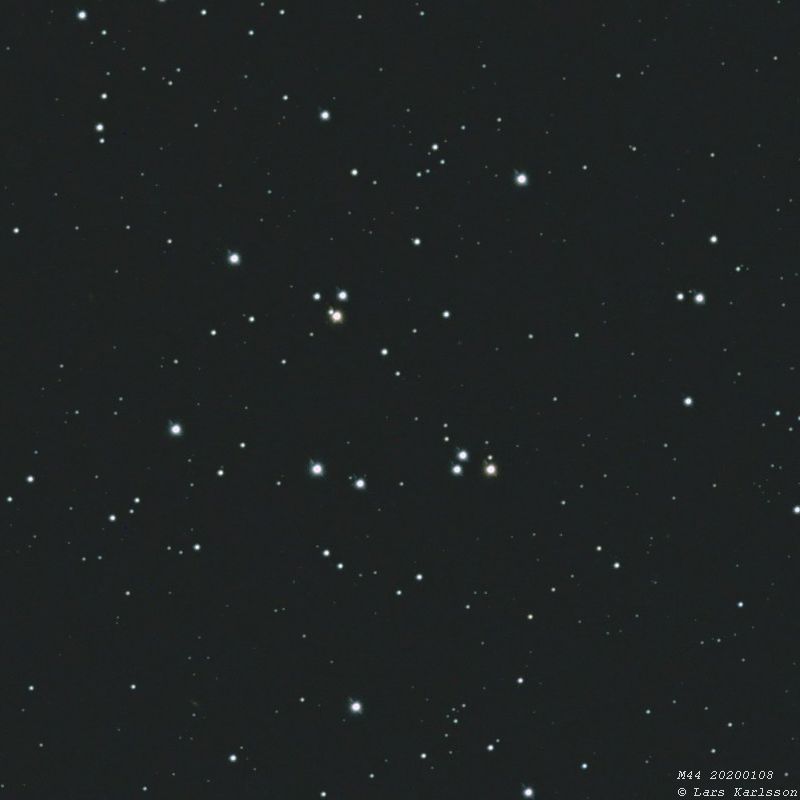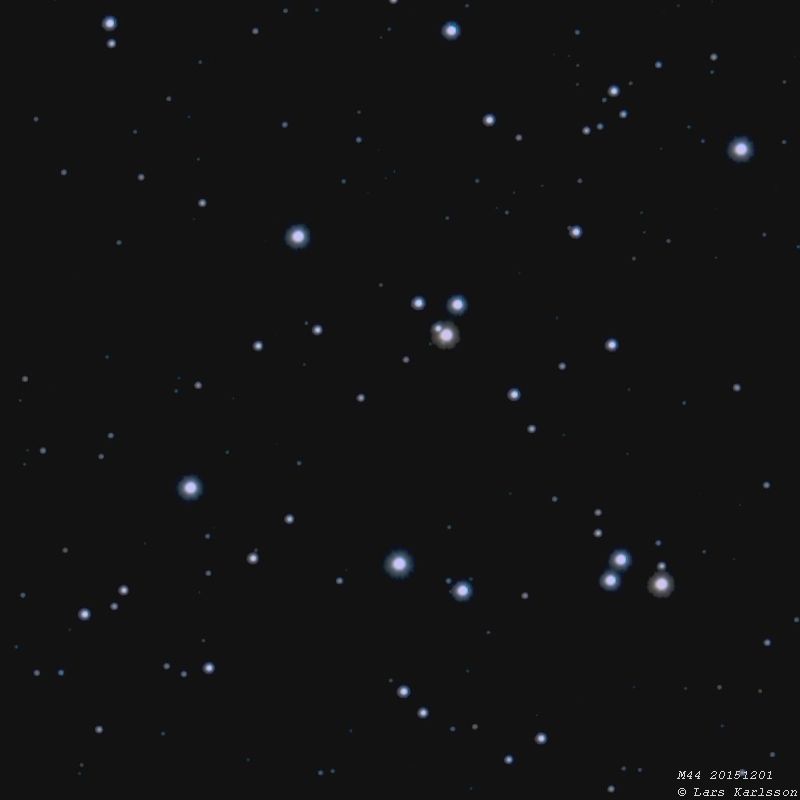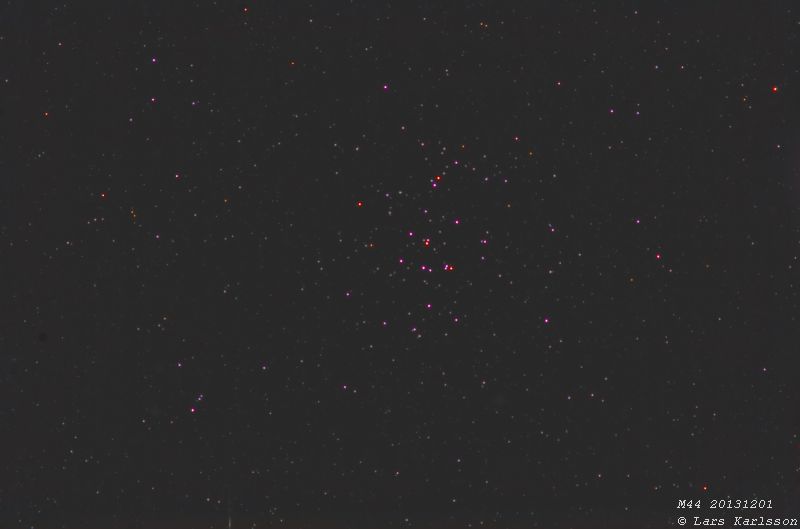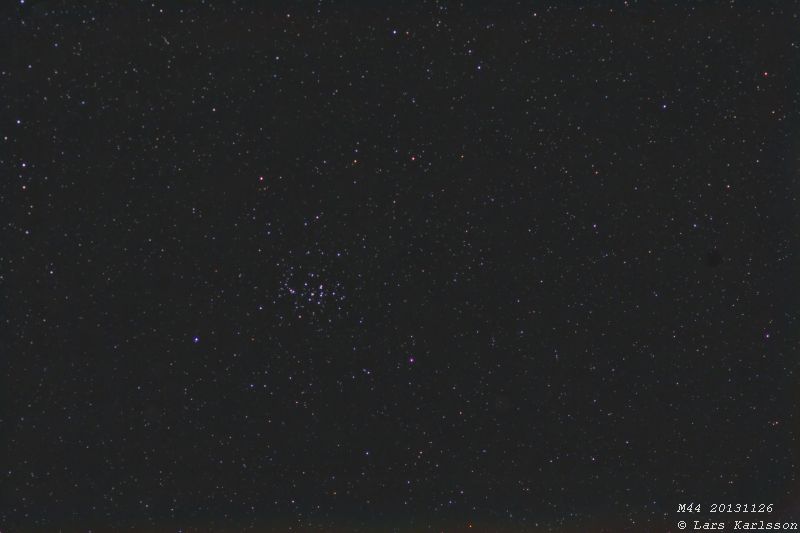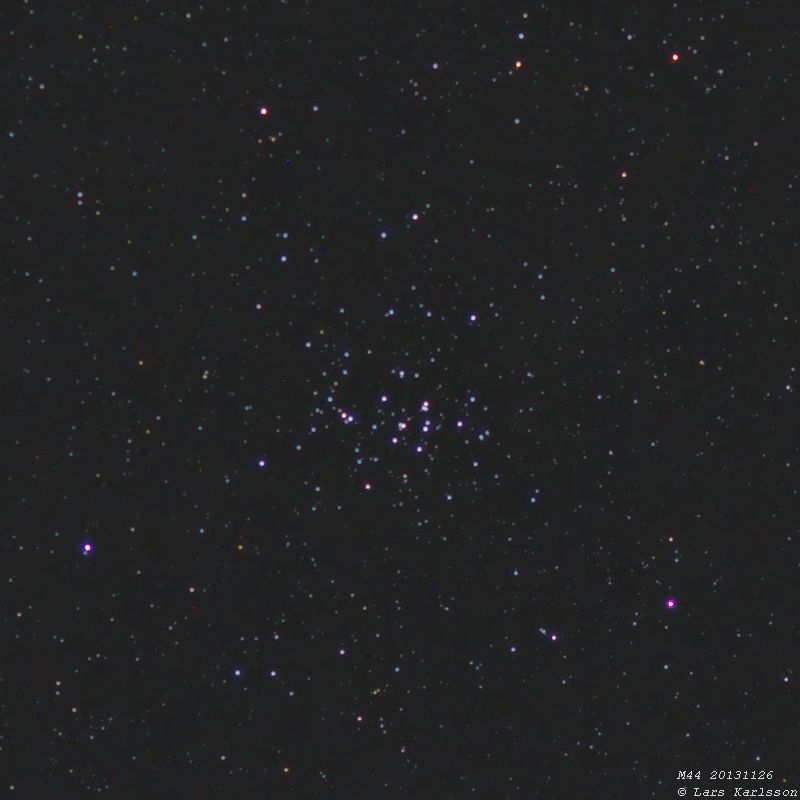| Object : | M44 |
| Coordinates/Direction : | RA: 08h40m, DEC: +19o59' |
| Object size : | 95' |
| Object magnitude : | 3.7 |
| More to know : |
Wikipedia:
https://en.wikipedia.org/ wiki/ Beehive Cluster |
| Exp. time : | 23x60 seconds, iso800, dithering mode |
| Image process tool : | Siril, Fitswork, Irfanview |
| Processing : | crop, resize, level, cal dark, bias, flat |
| Weather : | clear |
| Comment : |
This photo was taken from the roof of our house.
The roof is built of wood and not stable enough, but the view is wonderful.
Look at the full resolution image and you will see that the stars are not perfect round.
I can stop down the lens to f/5.6 and it will be better, but first I try to do some adjustment and get it better fully open.
I have got some new stains on the sensor, it's complicated to remove. |
| Date : | 2022-02-26 |
| Time (UT) : | 23:33 to 00:05 |
| Comment : |
Plate Solving of this image to get information about all the small weak objects.
You can do it here:
Astrometry.net .
Can you see them ? |
| Exp. time : | 23x60 seconds, iso1600, dithering mode |
| Image process tool : | AstroImageJ, Fitswork, Irfanview |
| Processing : | level, cal flat, dithering no bias & dark, noise filter |
| Weather : | clear sky |
| Comment : |
In Southern I have a clear but narrow view from our balcony in almost exactly Southern direction.
In January the Open Cluster M44, the Beehive Cluster passing by.
This cluster take up the same angle as three Moons and is easy to see from a dark sky, not what I have where I live but I can still take photos of it.
I have many of photos of this cluster from earlier, but I had some problem to open the files which I now have solved,
see how to rotate .cr2 files.
Compare different photos how they looked with the older equipment below. |
| Date : | 2020-01-08 |
| Time (UT) : | 23:53 to 01:23 |
| Comment : |
A zoom in on the ten brightest stars in center of the M44 open cluster. |
| Exp. time : | 19x60 seconds, iso800, not many of the photos was used because of clouds |
| Image process tool : | AstroImageJ, Fitswork, Irfanview |
| Processing : | level, cal flat, dithering no bias & dark, noise filter |
| Weather : | limited clear sky with lot of clouds that come and go |
| Comment : |
It's not often I have the telescope pointing at the Southern direction because of the narrow angle I have a free view out from in this direction.
This cluster is very beautiful to look at in a small telescope, my own telescope is only for photographing but I seen it from my friends telescopes.
This photo was taken 2 years earlier than the above. It's the same setup of the telescope as I have now in 2020. |
| Exp. time : | 48x60 seconds, iso800, dithering mode |
| Image process tool : | AstroImageJ, Fitswork, Irfanview |
| Processing : | level, cal flat, dithering no bias & dark, noise filter |
| Weather : | clear sky |
| Comment : |
In 2016 I bought a new camera to replace my old Canon 5D. The new camera is the Canon 6D, lower noise and higher sensitivity.
The telescope setup at this time was with a field flattener with reducer that reduce the focal length to 682 mm, compare with it's normal focal length 910 mm.
I did that because I want a brighter (faster) telescope, f/5.3 instead of f/7. |
| Date : | 2015-12-01 |
| Time (UT) : | 23:38 to 00:41 |
| Comment : |
This is a 800 x 800 1:1 crop of above photo. The APO telescope handle the color very good, no color bleeding around the bright stars.
An APO (short for Apochromat) lens means it's a lens designed to handle the color much better.
In this case the main lens is a triple design and much more complicated and expensive compare to an achromat's double lens design.
Apochromat Wikipedia and Achromat Wikipedia |
| Exp. time : | 39x30 seconds, iso1000, dithering mode |
| Image process tool : | AstroImageJ, Fitswork, Irfanview |
| Processing : | level, cal flat, dithering no bias & dark, noise filter |
| Weather : | clear sky |
| Comment : |
This photo is taken with a Pentax 500 mm f/4.5 lens, I had that one before I bought the APO telescope.
The color control is not very well in these old designed camera lenses.
It has a five lens element design, two lenses in the main lens and three lenses in the field flatter.
The color bleeding can be reduced in the image processing but not as good as if had not been there from the beginning.
The lens had a big opening, f/4.5, a very fast lens, less good was the heavy vignetting. |
| Exp. time : | 20x15 seconds, iso1000 |
| Image process tool : | AstroImageJ, Fitswork, Irfanview |
| Processing : | level, cal flat, dithering no bias & dark, noise filter |
| Weather : | clear sky |
| Comment : |
This is a wide angle photo of the M44 open cluster.
The lens is an very old Pentax 67 medium format lens, the medium format means it is designed for a whopping 60x70 mm big sensor (film).
It hold down the vignetting to almost nothing when used on a full frame camera.
In that time I had my old Canon 5D camera.
But the camera & lens combination takes good looking photos.
With a little bit more care of the settings of the mount and focus this image had been very good for a photo taken from my balcony. |
| Date : | 2013-11-25 |
| Time (UT) : | 22:27 to 22:36 |
| Comment : |
This is a 800 x 800 1:1 crop of above photo. Old lenses are a bit softer and does not give razor sharp images.
One advantages is that when the stars are spread out on many pixel it doesn't oversaturate and then keep the colors much better.
This is only a five minute exposure with an old low sensitive camera. |
 (click on the image to get one in full resolution in a new window)
(click on the image to get one in full resolution in a new window)
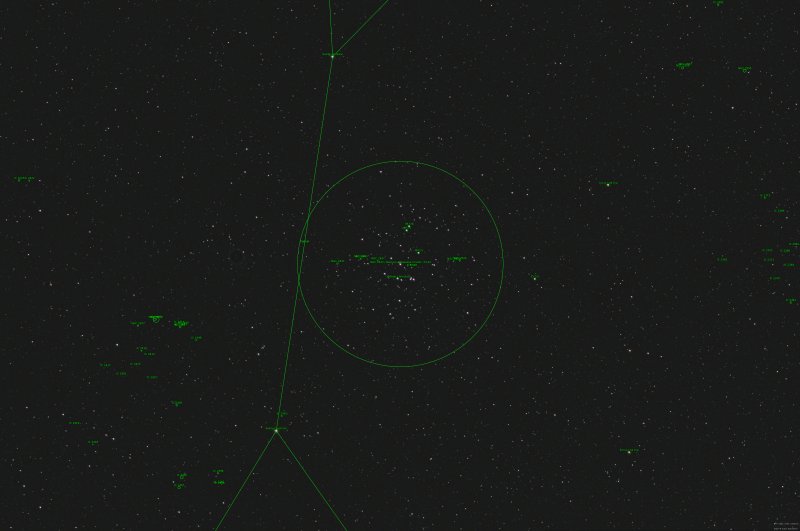 (click on the image to get one in full resolution in a new window)
(click on the image to get one in full resolution in a new window)
